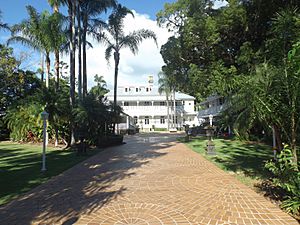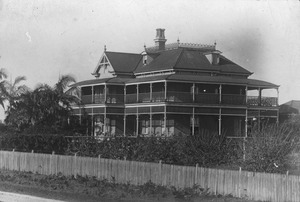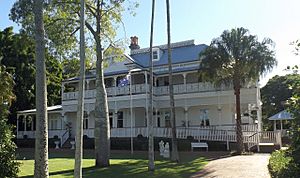Whepstead, Wellington Point facts for kids
Quick facts for kids Whepstead |
|
|---|---|

Front view, 2015
|
|
| Location | Main Road, Wellington Point, City of Redland, Queensland, Australia |
| Design period | 1870s - 1890s (late 19th century) |
| Built | 1889 |
| Built for | Gilbert Burnett |
| Architect | Claude William Chambers |
| Official name: Whepstead, Bay View Private Hospital, Fernbourne | |
| Type | state heritage (landscape, archaeological, built) |
| Designated | 21 October 1992 |
| Reference no. | 600776 |
| Significant period | 1870s-1890s (fabric, historical) |
| Significant components | residential accommodation - main house, garden/grounds, views to, views from, service wing, attic |
| Builders | Patrick Horisk |
| Lua error in Module:Location_map at line 420: attempt to index field 'wikibase' (a nil value). | |
Whepstead is a beautiful old house in Wellington Point, Queensland, Australia. It was built in 1889 by Patrick Horisk and designed by architect Claude William Chambers. This special house is also known as Bay View Private Hospital and Fernbourne. It was officially recognized as a heritage site on October 21, 1992, meaning it's an important part of history.
The Story of Whepstead House
Whepstead is a large, two-story timber house with a big attic. It was built in 1889 for Gilbert Burnett, a wealthy landowner and sawmill owner in Wellington Point. Originally, the house was called Fernbourne. It was designed by architect Claude William Chambers and built by Patrick Horisk. When it was first built, people thought it was one of the best houses in the area. It had amazing views of the sea and islands.
Gilbert Burnett's Early Life
Gilbert Burnett came to Queensland from England in 1866 when he was 20. He first managed a sugar plantation. Later, he worked at Ormiston House Estate, another sugar plantation. In 1875, he leased a large piece of land near Wellington Point. He bought this land in 1881.
Trafalgar Vale Estate
Burnett named his land Trafalgar Vale. He started it as a sugar plantation. He bought sugar mill machinery and set up his own mill. By 1883, his sugar cane fields were growing well. He also had a sawmill and a bone-mill, which made fertilizer for the cane.
From Sugar to Sawmilling
Burnett's main business changed from sugar to sawmilling. He expanded his sawmill because there was a high demand for timber. By 1884, he stopped growing sugar. He focused on his sawmill, which became one of the biggest in the colony.
He bought new machines to cut soft timbers like pine and cedar. He even had a steamer, the Eucalypta, to bring timber from nearby islands and rivers. A wharf was built to unload the timber. A tramway was laid to move logs from the wharf to the mill. The mill could produce a lot of timber each week. By 1889, the sawmill employed 50 workers.
Developing Wellington Point
In the mid-1880s, Burnett worked with other businessmen to divide his Trafalgar Vale land into smaller blocks. This was called the Wellington Point Estate. The land sold well because a railway line was being built to Wellington Point.
Gilbert Burnett was very important in the local community. He was a Justice of the Peace and a leader on the local council. In 1889, he built the grand house we now call Whepstead. It was made from cypress pine from his own sawmill. It was a very impressive house with 14 rooms on three levels.
The ground floor had a drawing room, dining room, breakfast room, study, and a large entrance hall. A grand wooden staircase led to the first floor. Here were four main bedrooms, all opening onto wide verandahs. These verandahs offered wonderful views of the countryside and the bay. Another staircase led to two attic bedrooms.
The Beautiful Gardens
In 1889, Fernbourne (Whepstead's original name) sat in a large garden of about 4.5 acres. This garden was first created in the mid-1870s. It had an orchard, vineyard, flower beds, and ornamental trees. There were also special areas with ferns, orchids, and palms. The garden was watered from a deep well. This water also supplied the house and its fountains.
Changes Over Time
Whepstead was built during a time of great growth in the 1880s. But in 1891, Gilbert Burnett faced financial difficulties. His house and its grounds were sold. It was bought by Edward Robert Drury, a bank manager. The Burnett family moved to a smaller house nearby, which they also named Fernbourne. It's believed that the first Fernbourne was renamed Whepstead around this time.
The Burnett family continued to run their sawmill until around 1899. Gilbert Burnett later worked for the government. He died in 1925. Many streets around Whepstead are named after him and his children.
After the Burnetts left, Whepstead had several different owners and renters. In the late 1890s, a government minister lived there. Later, a pastoralist (someone who raises livestock) named Edgar Gustav Parnell owned it from 1911 to the mid-1930s.
In 1943, Matron Ethel Dolley bought the house. She turned it into the Bay View Private Hospital. Some changes were made to the house for the hospital. It remained a hospital until 1973. After that, it became a private home again. In 1977, the land around Whepstead was divided. The house was sold and turned into a restaurant. It has been a restaurant and event center ever since.
What Whepstead Looks Like
Whepstead is a large, two-story building with an attic. It is made of timber and sits on top of a small hill. It is surrounded by beautiful gardens and old trees. These include camphor laurels, palms, and fig trees. A very old Moreton Bay Fig tree on the next property also adds to the garden.
Whepstead and its gardens are a well-known landmark in Wellington Point. From the second floor of the house, you can see amazing views of Waterloo Bay and Moreton Bay. You can also see a 360-degree view of the surrounding area.
The house has a corrugated iron roof with gables and a flat section in the middle. This flat section is surrounded by a decorative iron fence. The house stands on timber stumps and has verandahs all around it.
The roof has small windows called dormer windows. The gables have fancy ironwork and timber decorations. The verandahs have curved roofs. The first-floor verandah has decorative iron brackets and railings. The ground-floor verandah has iron brackets and timber railings.
Some parts of the verandahs have been enclosed. For example, the ground floor verandah on the south side is now a glassed-in function room. The west verandah is now a corridor.
A single-story kitchen and service area are attached to the northwest side of the house. This part also has a corrugated iron roof.
Inside, French doors with fanlights open onto the verandahs. The main entrance has a carved timber staircase. There is a central hallway with dining rooms and a lounge. The lounge has a beautiful marble fireplace. The walls are made of timber boards.
The first floor has a large banquet room with a marble fireplace. The rest of this floor is now one big function space. A steep timber staircase leads from the first floor to the two attic rooms.
The grounds around the house include a swimming pool and a playground. There is also a timber gazebo and a fountain.
Why Whepstead is Important
Whepstead was added to the Queensland Heritage Register on October 21, 1992. This means it is a very important historical site.
A Glimpse into the Past
Whepstead was built in 1889 during a time of great economic growth. It shows the confidence and success of that era. It is a rare example of a grand house from the 1880s in the Redlands area.
Learning from the Land
The gardens around Whepstead might still hold clues about how gardens were designed in the 1870s and 1880s. This could teach us about gardening in the past.
A Great Example of Design
Even with some changes, Whepstead still shows what a large, fancy timber house with three levels looked like. It is also a good example of the early work of the important architect Claude William Chambers.
Beautiful to Look At
Whepstead's beautiful outside, with its old trees and garden, makes Wellington Point look special. Inside, the carved timber staircase and other woodwork are also very artistic. The amazing views from and to the house are also very important.
A Local Landmark
For over a hundred years, Whepstead has been a well-known landmark in Brisbane's bayside suburbs. People in the local community and Brisbane value it as a unique part of their history.
Connected to a Key Figure
Whepstead house and its gardens are strongly connected to Gilbert Burnett. He played a very important role in developing Wellington Point in the late 1800s.







